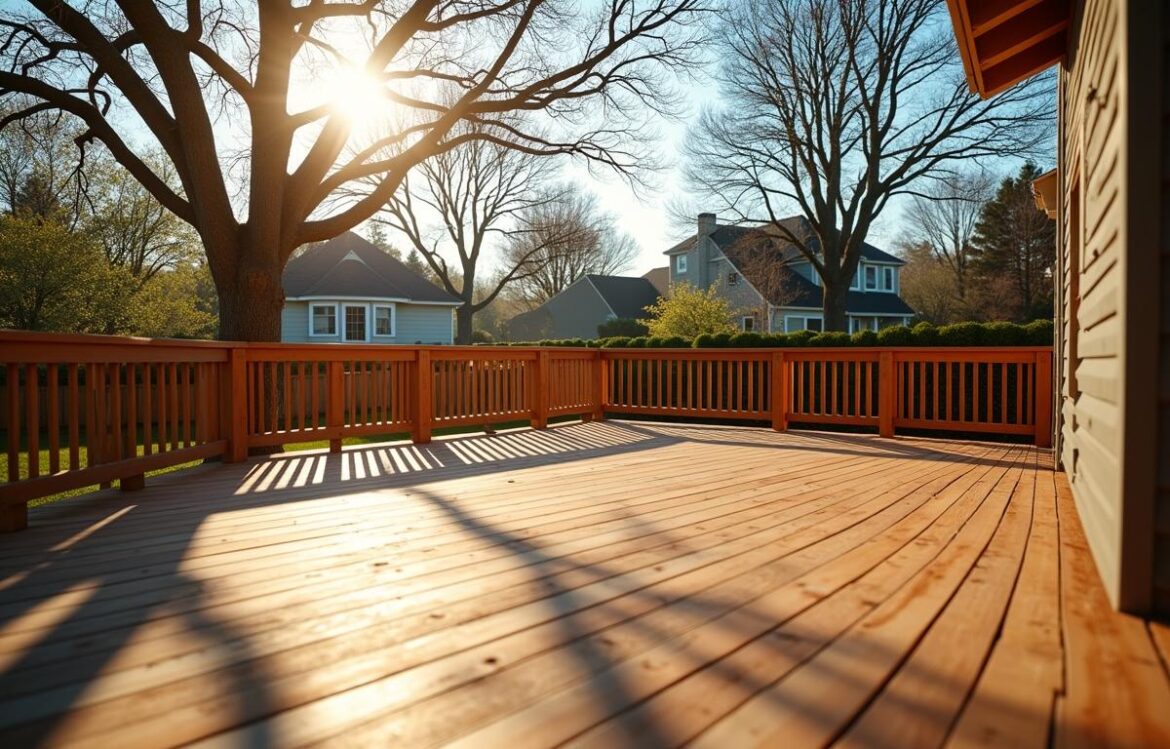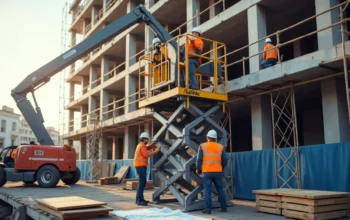The Best Time of Year to Build or Repair a Deck
To ensure durability and safety, consider timing when you decide to build or repair a deck. There’s nothing quite like stepping out onto a freshly finished surface that’s ready to host friends, family, and all your favorite activities. The challenging part often lies in figuring out when to start your deck construction or upgrade your existing one.
Whether you’re aiming for modern deck design ideas or a classic style with pressure-treated wood, proper timing helps you avoid setbacks like extreme temperatures, heavy rainfall, or scheduling conflicts with busy contractors. It also makes deck repair techniques more effective, ensuring you won’t have to redo your work a few months later.
Why Timing Is Everything for Deck Construction and Maintenance
Choosing the most favorable season can change everything from how quickly deck materials dry to how smoothly deck building codes are followed during inspections. Weather fluctuates, and climates vary from region to region, but there are broad guidelines to help you figure out the ideal window.
Deck construction often requires reliable conditions so that wood or composite decking doesn’t warp, crack, or fail to set properly. If you’re planning a deck restoration project, moderate temperatures also make deck staining or deck sealing more resilient. The type of climate you live in has an impact, so it’s wise to look at historical weather patterns before pulling the trigger on that deck installation.
Considering Weather Patterns
Dry weather shortens the time needed for deck stain and sealant to fully adhere. High humidity can extend drying times, and heavy rain might ruin an incomplete deck structure. That’s why many contractors suggest late spring or early fall for any major deck repair techniques. These transitional seasons often provide enough warmth for proper curing without the extreme heat of mid-summer or the frost of winter.
Winter poses a unique challenge for outdoor decking projects because materials like pressure-treated wood can become brittle in freezing temperatures. Composite decking options may tolerate cold better, but consistent snow or ice can slow progress and raise costs. Meltwater can also disrupt deck drainage solutions if not accounted for in the design phase.
Spring: A Fresh Start for Deck Projects
Spring brings mild temperatures that help your deck building materials acclimate. When frost has disappeared and the ground isn’t too moist, it’s often the perfect moment to start a deck restoration or finalize new deck construction. You’ll typically have enough time to enjoy your outdoor living space during summer without worrying about last-minute repairs.
Another advantage of spring is that it allows you to scout for new deck design ideas. You can explore deck railing styles, research different deck materials, or even consider adding a custom pergola installation to provide shade. With the weather improving, it’s also simpler to gather volunteer helpers for a DIY deck project if you’re planning to do some of the construction yourself.
Early Spring Preparation
You don’t want to jump into deck maintenance right after the last snowfall. Give the ground a chance to thaw and dry out. If the soil is too damp, you risk uneven settling for footings, which can compromise deck safety standards later. Checking your local forecasts and consulting a contractor (if you’re not going the DIY route) can help you plan precisely.
Before any wooden deck installation or composite decking setup, evaluate the site with a deck inspection method. Ensure your existing structure, if you have one, is stable. This step can reveal whether you need additional deck repair costs factored in. Also, check for pests, such as termites, which can weaken deck hardware.
Summer: Peak Season for Outdoor Living
Summer invites plenty of sunshine and also a flurry of home improvement projects. Many homeowners use this time for patio enhancement or to upgrade their deck railing options. Because the weather typically stays dry, it’s straightforward to apply deck stain and sealant. However, summer heat can pose some hurdles if it’s too intense.
Builders often find themselves swamped with work, which influences scheduling. If you have flexibility, you can still manage a DIY deck project. Just keep an eye on extreme heat. High temperatures might make it tricky to handle pressure-treated wood, and you’ll need to be mindful of deck safety tips like wearing protective gear to avoid heat-related hazards.
Mid-Summer Considerations
If midsummer is your only option for projects like deck refinishing, try to work in the cooler parts of the day. Morning or late afternoon hours are best for applying deck stain and deck sealing products. That helps avoid bubbles or uneven brushing caused by quick-drying sealant on hot surfaces.
Consider adding shade to your workspace. Simple solutions like a canopy or a temporary pergola structure can keep the work area cooler. While you’re at it, remember that deck furniture and décor are easier to place or remove before or after a major project, so plan to store them somewhere safe if you’re re-staining your existing deck.
Fall: Ideal Temperatures and Less Rush
Fall often balances cool nights with pleasantly warm days, which can be perfect for deck repair techniques or a brand-new deck installation. Contractors might have more availability after the summer rush, or you can go at your own pace without worrying about scorching heat. Autumn weather also provides a good test for deck drainage solutions, ensuring your design efficiently channels away any rainfall.
With fall’s moderate temperatures, deck maintenance tasks like sealing, staining, or replacing worn boards become simpler. You can also incorporate deck landscaping elements, such as potted plants or built-in planters, to boost curb appeal. If you get everything done in early fall, you’ll be able to enjoy a comfortable outdoor space before winter arrives.
Late Fall Warnings
As leaves begin to drop, ensure you clear away debris to avoid moisture buildup. Wet leaves that accumulate can compromise a freshly restored surface, leading to mold or staining. Additionally, watch out for earlier sunsets. Shorter days mean you’ll have fewer daylight hours to accomplish tasks like deck hardware upgrades or deck railing replacements.
If you miss the ideal weather, you may have to wait until the following spring to perform any major deck maintenance. Attempting significant projects too closely to winter might leave you with unfinished or partially cured surfaces vulnerable to freezing conditions.
Winter: Special Cases and Off-Season Advantages
For most people, winter isn’t the best time for a wooden deck installation or an extensive deck restoration. The cold can cause materials to expand and contract, adhesives won’t set correctly, and consistent precipitation can delay work for days or weeks. However, if you live in a mild climate or have indoor workspace available for prefabrication, winter might be an option.
Some contractors offer off-season discounts, which can reduce deck repair costs or make certain enhancements, like deck lighting installations, more affordable. Just be sure to confirm local deck building codes before you start, especially if the ground is frozen. A professional assessment can confirm whether it’s safe and feasible to undertake your project at this time.
Handling Winter Projects Safely
Expect longer timelines. Your main challenge will be keeping materials at stable temperatures while ensuring deck safety tips are followed. If you’re determined to work on a DIY deck project, keep surfaces dry and check local weather patterns daily. Any sign of heavy snowfall or ice storms is a strong indication to pause your work.
Winter building also demands specialized deck inspection methods. Look for hidden cracks, warping, or any moisture damage that might worsen in freezing weather. While you can accomplish certain tasks, hold off on final staining or sealing until milder conditions return, unless you have specialized products formulated for cold climates.
Planning Ahead for Future Deck Projects
Thinking about next year’s deck projects? Whether you’re aiming for deck landscaping, adding a pergola installation, or refining deck railing options, get a head start by gathering materials and ideas before your desired season. Early research on composite decking or pressure-treated wood can save you from last-minute scrambling.
If you maintain a yearly schedule, deck maintenance becomes more predictable. You can plan your deck refinishing, deck staining, or deck hardware replacement in advance. That way, your outdoor decks remain safe, visually appealing, and ready to handle everything from lively parties to quiet afternoons. By keeping a flexible timeline, you’ll have the freedom to choose exactly when to build or restore your deck without unnecessary stress.
Final Thoughts on Seasonal Deck Work
Seasonal timing can bring out the best in your deck construction and deck maintenance efforts, whether you’re starting fresh with new materials or upgrading an existing surface. By picking the right season, you ensure that labor, wood acclimation, and sealing processes align with nature’s offer of improved temperatures and moderate moisture levels.
Aim for spring or fall if you want to avoid harsh weather extremes, and keep summer as a backup option if you’re comfortable navigating the hot sun and seeking out contractor availability. And if winter is your only choice, be prepared for slower progress and potential cold-weather obstacles. No matter your choice, a well-timed project will make your outdoor space a destination for relaxation, gatherings, and memorable moments for years to come.




